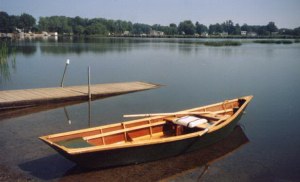 The
boat we're building is based on the book Building
The Weekend Skiff by Richard Butz & John Montague, Tiller
Publishing, 605 S. Talbot St., Suite 2, St. Michaels, MD ISBN 1-888671-10-6
The
boat we're building is based on the book Building
The Weekend Skiff by Richard Butz & John Montague, Tiller
Publishing, 605 S. Talbot St., Suite 2, St. Michaels, MD ISBN 1-888671-10-6
Butz and Montague, of Buffalo State College in Buffalo, New York, designed the Weekend Skiff especially for educational programs and community projects for young people. It uses simple materials and tools to produce an attractive, seaworthy boat that can be built as a rowing skiff, small motor boat, or sailboat.
We've chosen the sailing version, which adds a number of components to the basic hull, plus mast, spars, and rigging. This easily doubles the scope and expense of the project over a simple rowing skiff.
 |
|
This
fine example of a Weekend Skiff is made with lauan plywood sides. You
can read more about it at the Herkimer
& Perkins site.
|
Another fundamental decision to make is the quality of materials you're going to use. To keep cost to the absolute minimum, you can build these simple hulls using garden variety lumber yard plywood, and finish with a good quality exterior house paint. A better option others have used is to make the hull sides from lauan, which is free of voids, and pretty to boot, and can be finished with epoxy and varnish if you choose.
Or you can do what we've done and use marine plywood, which has the same adhesives as exterior grade but is free of voids and has a minimum of 'football' shaped patches in the veneer. I bought birch veneer, which is the most reasonably priced in our area, though other nicer woods are available if you can afford them. It is finished with with 3 coats of epoxy and several coats of varnish on the inside of the boat, and epoxy and fiberglass cloth on the outside of the hull, followed by a couple of coats of a decent marine alkyd enamel paint.
 |
|
|
The
wood for the chine logs, gunwales, and seat risers has to bend quite
a bit.
|
One place you will probably not be able to skimp is in the long pieces of 1x2 for the chine logs, gunwales and seat risers, as well as the keelson and inwales if you're building a sailboat. Unless you're lucky enough to find 16 foot boards with only a few small, tight knots, the odds are you won't be able to bend these pieces in without risk of breaking them. So bite the bullet, open your wallet, and find yourself a source for at least clear pine for these parts. The many shorter pieces of stock needed for the frames, transom battens, seats, seat battens and thwarts can easily be gotten out of regular grade boards if you don't mind cutting around the knots.
You must also choose what materials to use for fasteners and fittings. I expect that our boat will spend most of its life in a garage and will be sailed almost entirely in fresh water. Given these conditions, just about any material reasonably fit for marine use would work fine. Many of the boats I've seen here on the Great Lakes seem quite content to mix aluminum, stainless steel, and the occasional bit of bronze and brass without concern, except for a some sacrificial chunks of zinc affixed somewhere on the keel. Obviously you can get away with a lot in fresh water.
I can't predict just where this boat is going to end up in its lifetime, however. I expect my daughter to leave home in a few years and take the boat with her. If she winds up on the coast, it would be nice to know that I haven't set her up for corrosion problems. So I'm using bronze for fasteners and fittings that are permanently affixed to the hull. I see no reason not to use common (and inexpensive) stainless blocks for the running rigging which can be replaced before the boat has to spend much time in salt water.
You'll need to resolve a lot of other issues as you build your boat. I'll deal with a many more as we get into Construction.
For now, let's go on to some more about The Rig...
| Home |